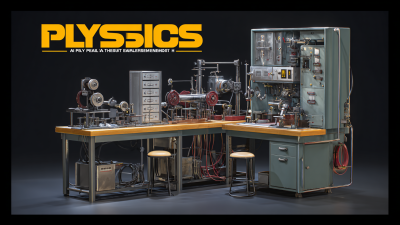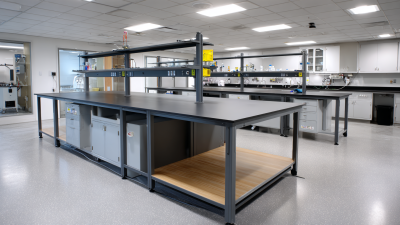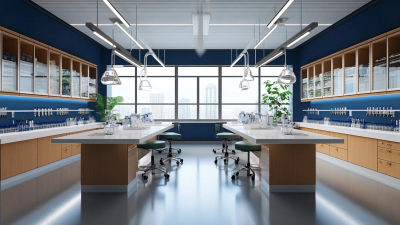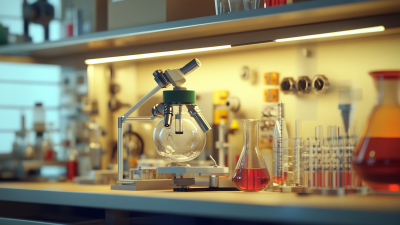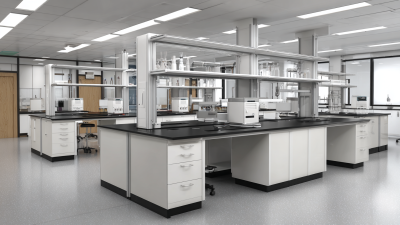The modern educational landscape continually seeks innovative approaches to enhance student engagement and comprehension, especially in the realm of science. Among these advancements, the "Physics Laboratory Bench" stands out as a transformative tool that reshapes the learning experience in physics education. This essential component of any physics laboratory provides a hands-on environment where theoretical concepts come alive through experimentation and exploration. By engaging students directly with experimental setups, the Physics Laboratory Bench not only deepens their understanding of physical principles but also cultivates critical thinking and problem-solving skills.

In this article, we delve into the myriad ways that the Physics Laboratory Bench transforms learning, allowing students to witness firsthand the wonders of physics in action, hence fostering a passion for discovery that lasts beyond the classroom.
Hands-on experimentation is a cornerstone of effective physics education, transforming abstract concepts into tangible experiences. In a physics laboratory, students engage directly with the principles they study, from mechanics to electromagnetism. By conducting experiments, they not only visualize complex theories but also develop essential skills such as critical thinking and problem-solving. This interactive approach fosters a deeper understanding of the scientific method, encouraging learners to hypothesize, test, and analyze results in real-time.
Furthermore, a well-equipped physics laboratory bench serves as a dynamic learning environment where students can collaborate and explore together. Working in teams during experiments enhances communication skills and promotes a sense of community among peers. Students learn to articulate their thoughts, share insights, and confront challenges collectively. This collaboration not only builds camaraderie but also mimics the workplace environment, preparing students for future scientific endeavors. The active engagement through hands-on experimentation thus not only enriches their educational experience but also inspires a lifelong passion for physics.
The role of laboratory benches in physics education extends far beyond mere functionality; they are vital instruments in fostering collaborative learning among students. According to a report by the National Science Teaching Association, collaborative learning can enhance student engagement and retention by up to 50%. In a well-equipped physics laboratory, students can work together to conduct experiments, share ideas, and discuss methodologies, creating a dynamic learning environment that promotes active participation.
Data from the Journal of STEM Education Research suggests that students who engage in collaborative experiments demonstrate a 20% improvement in problem-solving skills compared to those working in isolation.
Laboratory benches that facilitate group work enable students to tackle complex physics concepts collectively, allowing them to explain phenomena to one another and learn through peer interaction. This hands-on experience not only deepens their understanding of theoretical principles but also equips them with essential interpersonal skills that are relevant in both academic and professional settings.
The integration of technology in physics laboratories is revolutionizing the way students engage with the subject. Modern physics labs are equipped with advanced tools such as computer simulations, data analysis software, and interactive experiments. These resources allow students to visualize complex phenomena that might otherwise be abstract and intangible. For instance, simulations can demonstrate concepts like wave interference and particle motion in real-time, offering a dynamic learning experience that enhances understanding and retention.

Moreover, technology allows for a more personalized approach to learning. With various online platforms, students can access a wealth of resources, from instructional videos to virtual labs, catering to different learning styles. This accessibility enables learners to explore physics at their own pace and revisit challenging concepts. By fostering an interactive environment, technology not only clarifies theoretical ideas but also cultivates critical thinking and problem-solving skills essential for aspiring scientists.
These advancements ultimately create a richer educational experience, making physics more engaging and relevant to the modern world.
In today's educational landscape, the integration of experimental design in physics education is crucial for fostering critical thinking skills among students. According to a study published by the American Physical Society, students engaging in hands-on laboratory experiences improve their analysis and reasoning skills by up to 40%. This active participation not only deepens their understanding of fundamental concepts but also encourages them to develop hypotheses and conduct experiments, thereby cultivating a scientific mindset.
To further enhance your learning experience in physics lab work, consider implementing a few strategic approaches. Firstly, dedicate time to meticulously plan your experiments; this includes defining clear objectives, identifying variables, and anticipating potential challenges. Secondly, collaboration is invaluable. Engaging with peers allows for the exchange of ideas and insights, which can lead to more robust experimental designs. Lastly, always reflect on your findings and methodologies. This practice of self-assessment is vital for improving future lab work and advancing critical thinking capabilities.
By focusing on experimental design, students not only grasp physical principles but also hone essential skills that are transferable to various fields, such as engineering and data analysis. The physics laboratory bench serves as a catalyst for this transformative learning approach.

In recent years, research has highlighted the critical role that physical space plays in influencing student engagement and motivation within science laboratories. According to a report by the National Science Teachers Association, classrooms designed with adaptable spaces significantly enhance student collaboration and interaction. A well-organized laboratory bench not only facilitates hands-on experiments but also fosters an environment where students feel empowered to explore scientific concepts actively. When students are provided with flexible seating arrangements and accessible resources, their intrinsic motivation and participation rates can increase by up to 25%, as noted in a study by the Journal of Educational Psychology.
Moreover, the design of the learning environment can directly impact student attitudes towards science. A survey conducted by the American Educational Research Association found that 68% of students who worked in modern, well-equipped labs reported higher satisfaction and interest in physics and other sciences. Thus, when schools invest in optimizing their physics laboratories with thoughtful spatial arrangements, they do more than just improve the physical layout; they also enhance the learning experience, leading to better academic outcomes and a greater passion for science among students.
The transformative effect of a well-designed physics laboratory bench is evident, making a compelling case for prioritizing physical space in educational settings.
